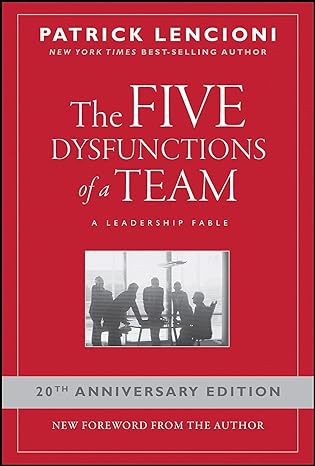
The Five Dysfunctions of a Team: A Leadership Fable - By Patrick M. Lencioni
Date read: 2018-05-13How strongly I recommend it: 8/10
(See my list of 150+ books, for more.)
Go to the Amazon page for details and reviews.
Split into an easy to follow fable and followed by the five dysfuntctions of a team and techniques to overcome them. Great for anyone who wants to maximize the output and effectiveness of their team.
Contents:
- DYSFUNCTION 1: ABSENCE OF TRUST
- DYSFUNCTION 2: FEAR OF CONFLICT
- DYSFUNCTION 3: LACK OF COMMITMENT
- DYSFUNCTION 4: AVOIDANCE OF ACCOUNTABILITY
- DYSFUNCTION 5: INATTENTION TO RESULTS
My Notes
If you could get all the people in an organization rowing in the same direction, you could dominate any industry, in any market, against any competition, at any time.
Trust is the foundation of real teamwork. And so the first dysfunction is a failure on the part of team members to understand and open up to one another.
Great teams do not hold back with one another. They are unafraid to air their dirty laundry. They admit their mistakes, their weaknesses, and their concerns without fear of reprisal.
Teamwork begins by building trust. And the only way to do that is to overcome our need for invulnerability.
The key is to define our goals, our results, in a way that is simple enough to grasp easily, and specific enough to be actionable.
Politics is when people choose their words and actions based on how they want others to react rather than based on what they really think.
If we don’t trust one another, then we aren’t going to engage in open, constructive, ideological conflict. And we’ll just continue to preserve a sense of artificial harmony.
Once we achieve clarity and buy-in, it is then that we have to hold each other accountable for what we sign up to do, for high standards of performance and behavior. And as simple as that sounds, most executives hate to do it, especially when it comes to a peer’s behavior, because they want to avoid interpersonal discomfort.
Be intolerant of behavior that demonstrates an absence of trust, or a focus on individual ego. Encourage conflict, driving for clear commitments, and expecting everyone to hold each other accountable. Call out bad behavior when you see it, and make sure your team is doing the same.
The first dysfunction is an absence of trust among team members. Essentially, this stems from their unwillingness to be vulnerable within the group. Team members who are not genuinely open with one another about their mistakes and weaknesses make it impossible to build a foundation for trust.
This failure to build trust is damaging because it sets the tone for the second dysfunction: fear of conflict. Teams that lack trust are incapable of engaging in unfiltered and passionate debate of ideas. Instead, they resort to veiled discussions and guarded comments.
A lack of healthy conflict is a problem because it ensures the third dysfunction of a team: lack of commitment. Without having aired their opinions in the course of passionate and open debate, team members rarely, if ever, buy in and commit to decisions, though they may feign agreement during meetings.
Because of this lack of real commitment and buy-in, team members develop an avoidance of accountability, the fourth dysfunction. Without committing to a clear plan of action, even the most focused and driven people often hesitate to call their peers on actions and behaviors that seem counterproductive to the good of the team.
Failure to hold one another accountable creates an environment where the fifth dysfunction can thrive. Inattention to results occurs when team members put their individual needs (such as ego, career development, or recognition) or even the needs of their divisions above the collective goals of the team.
Trust is the confidence among team members that their peers' intentions are good, and that there is no reason to be protective or careful around the group. In essence, teammates must get comfortable being vulnerable with one another.
Members of Trusting Teams:
Suggestions for Overcoming Dysfunction 1
The Role of the Leader:
Acknowledge that conflict is productive, and that many teams have a tendency to avoid it.
Teams that Engage in Conflict:
Suggestions for Overcoming Dysfunction 2:
The Role of the Leader: Demonstrate restraint when their people engage in conflict, and allow resolution to occur naturally, as messy as it can sometimes be.
Consensus - Great teams understand the danger of seeking consensus, and find ways to achieve buy-in even when complete agreement is impossible.
Certainty - Great teams also pride themselves on being able to unite behind decisions and commit to clear courses of action even when there is little assurance about whether the decision is correct.
A Team that Commits:
Suggestions for Overcoming Dysfunction 3:
The Role of the Leader:
A Team that Holds One Another Accountable:
Suggestions for Overcoming Dysfunction 4:
The Role of the Leader: Accountability has not been relegated to a consensus approach, but merely to a shared team responsibility, and that the leader of the team will not hesitate to step in when it is necessary.
Team that Focuses on Collective Results:
Suggestions for Overcoming Dysfunction 5:
The Role of the Leader: Be selfless and objective, and reserve rewards and recognition for those who make real contributions to the achievement of group goals.